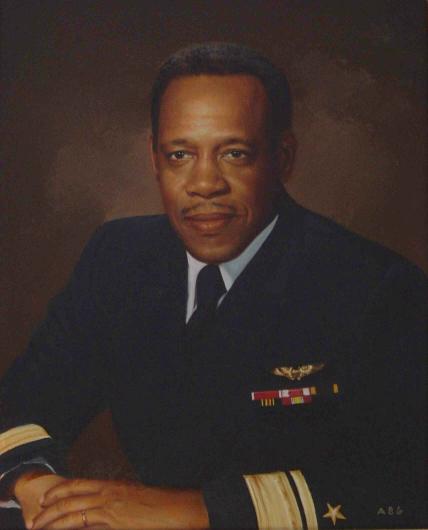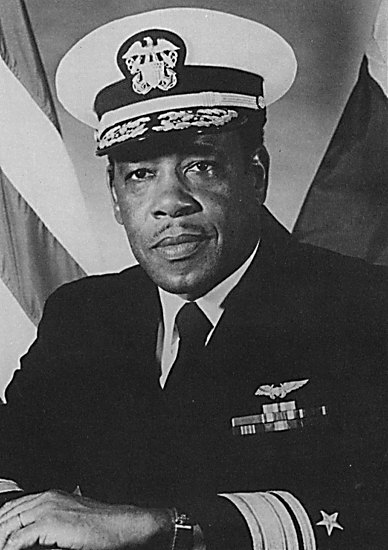Courtesy of the United States Navy:
Rear Admiral Benjamin Thurman Hacker was born in Washington, D.C., in September 19, 1935. Completing most of his high school in Daytona Beach, Fla., He attended the University of Dayton, Dayton, Ohio and Wittenberg University in Springfield, Ohio. He graduated 1 June, 1957 with a bachelor of arts degree in Science.
Upon completion of Aviation Officer Candidate School at Pensacola, Florida, he as commissioned an ensign in September, 1958. He was designated a Naval flight Officer on June 7, 1960. He served with Patrol Squadron 10 and Patrol Squadron 21 from June, 1960 to June, 1963. On March 19, 960, he was promoted to lieutenant junior grade and in 1963, he reported the Naval Postgraduate School in Monterey, Calif., where he completed the Engineering Science Curriculum. He was promoted to lieutenant on October 1, 1962.
In 1964, he reported to Patrol Squadron 31, Moffett field, California, where he served as personnel officer and a flight and ground instructor in the P-3A aircraft.
He attended Fleet Sonar School, Key West, Florida, in June, 1966 and in August, he reported to the U.S. Naval facility, Argentia, Newfoundland, where he served as operations officer. In 1967, he was assigned to the U.S. Naval facility, Barbados, West Indies as executive officer. He became commanding officer of that station in 1968. He was promoted to lieutenant commander at this duty station.
In 1970, Rear Admiral Hacker reported to Patrol Squadron 47, Moffett Field, Calif. During this tour, he completed numerous deployments in the P3C Aircraft to Adak, Alaska and the Western Pacific. He was promoted to commander at Patrol Squadron 47. In 1972, he established the Naval ROTC Unit at Florida A & M University, Tallahassee, Fla., and served as the first professor of Naval Science and commanding officer of this unit.
He reported to Patrol Squadron 24, Jacksonville, Florida, in October, 1973. He served for one year as executive officer, prior to assuming command in November, 1974. During this tour, the squadron completed deployments to Keflavik, Iceland, and was heavily tasked in major exercises in the Northern and Central Atlantic.
From 1975 to 1977, he was assigned to the Bureau of Naval Personnel as director, Equal Opportunity Divisions and special assistant to the Chief of Naval Personnel for Minority Affairs, Washington, D.C. He became a captain on Sept. 1, 1977. In June, 1978, he completed studies in National Security Policy at the Industrial College of the Armed forces, and earned a Master of Science Degree in Business Administration from the George Washington, University.
In August, 1978, he was assigned as commanding officer of Naval Air Station, Brunswick, Maine and in August, 1980, he assumed duties as commander, U.S. Military Enlistment Processing Command with headquarters in Fort Sheridan, Illinois. On September 1, 1980, he was designated a Rear Admiral while serving in this billet.
In 1982, he reported for duties as commander Fleet Air Mediterranean; commander, Maritime Surveillance and Reconnaissance forces, U.S. Sixth fleet; and commander, Maritime Air forces, Mediterranean, with headquarters in Naples, Italy.
He assumed duties as director, Total Force Training and Education Division (OP-11) on the staff of the Chief of Naval Operations in October, 1984. In May, 1986, he was awarded an honorary degree of Doctor of Education honoris causa by the George Washington University, Washington, D.C.. Rear Adm. Hacker became commander, NTC in August, 1986. following NTC, he became commander, Naval Base, San Diego.
He holds the Defense Superior Service Medal; the Legion of Merit; the Meritorious Service Medal; the Navy Unit Commendation; the National Defense Service Medal; and the Armed Forces Expeditionary Medal (Cuba).
From a contemporary news report:
Rear Admiral Benjamin T. Hacker, United States Navy (retired), age 68, of Norfolk, Virginia, passed away on December 28, 2003 at Sentara Norfolk General Hospital.
Born in Washington, D.C., he was a graduate of Wittenburg University in Springfield, Ohio. After completing Aviation Officer Candidate School in Pensacola, Florida, he was commissioned an Ensign in 1958. He was selected for flag rank in the Navy in 1980, and assumed duties as Commander U.S. Military Enlistment Processing Command with headquarters in Fort Sheridan, Illinois. In 1982, he became Commander Fleet Air Mediterranean; Commander Maritime Surveillance and Reconnaissance Forces, Sixth Fleet; and Commander Maritime Air Forces Mediterranean with headquarters in Naples, Italy.
After retiring from the United States Navy in 1988, he served as the director of the California Department of Veterans Affairs and also held posts as a Regional Senior Vice President/General Manager for United Services Automobile Association (USAA) in the company's Western Region headquartered in Sacramento, California, and Mid-Atlantic Region, headquartered in Norfolk, Virginia. Rear Admiral Hacker retired from the USAA in 1998 and served on numerous local and national boards.
Rear Admiral Hacker was the first Naval Flight Officer in the Navy to be selected for Flag Rank. He held ten commands over the course of his 30 year military career. Included among Rear Admiral Hacker's personal decorations are the Defense Superior Service Medal, the Legion of Merit with three Gold Stars, and the Meritorious Service Medal.
In his own life example, he symbolized what was right about the United States military, what was noblest and best. Throughout his military and professional careers he worked tirelessly in support of equal opportunity initiatives. His life touched countless people and his efforts paved the way for many to follow.
A memorial service will be held at 4 p.m, Saturday, January 3, 2004 at Bank Street Memorial Baptist Church, Norfolk, Virginia. Viewing will begin at 3 p.m., prior to the service. A funeral will be held at Arlington National Cemetery with full military honors at a date yet to be determined.
Admiral Hacker is survived by his wife, Jeanne; mother, Alzeda, and three children, Benjamin Jr., Bruce and Anne. In lieu of flowers, the family requests that memorial donations be made to the Leukemia & Lymphoma Society of American, 1311 Mamaroneck Avenue, White Plains, New York 10605 in memory of Rear Admiral Benjamin T. Hacker.
US Navy Photo
Tuesday, February 24, 2004
Ceremony to honor late FAMU professor
Hacker started Naval ROTC program
A crowd of friends, family and colleagues is expected to gather in Arlington National Cemetery on Wednesday to remember Florida A&M University's first naval commanding officer and professor of naval science.
Rear Admiral Benjamin T. Hacker, who died December 28, 2003, at age 68, is credited with building from scratch FAMU's Naval Reserve Officers' Training Corps program. Until 1972, historically black colleges did not have Naval ROTC units. That year, FAMU and four other historically black colleges received units.
“The U.S. Navy wanted to provide more opportunities for minorities to become naval officers,” said Captain Tom Daniel, FAMU's current professor of naval science. “(Hacker) was hand-picked at that time to come here.”
Daniel met Hacker in 1979 and continued a friendship with him.
In fact, Hacker encouraged Daniel to take his current position at FAMU.
After Daniel accepted the assignment at FAMU, Hacker told Daniel in a letter it was one of the most fulfilling positions in his 30-year military career.
“I congratulate you on a command assignment which I consider to be an honor and a major responsibility and challenge,” Hacker wrote on July 25, 2002. “I expect that you will find as I did, this to be one of your most fulfilling assignments.”
More than 400 Navy and Marine Corps officers have graduated from the ROTC program since Hacker launched it. The program also trains students from Florida State University and Tallahassee Community College.
FAMU Naval ROTC student Richlyn Neal said she is grateful for Hacker's investment.
“By him doing this, he opened a whole new avenue on a HBCU campus,” said Neal, a public-relations student. “I have the opportunity to go to college and become an officer in the military.”
Neal, 20, said she admires Hacker's rank of rear admiral – something that was a rarity for minorities 20 years ago.
Hacker also became the first person to rise from a naval flight officer to rear admiral. A naval flight officer is not a pilot but is responsible for flight plans and navigation.
“It was very, very hard for someone to become an admiral who was not a pilot,” Daniel said. “He was able to break that pattern.”
Hacker – who lived in Norfolk, Virginia, when he died – retired from the Navy in 1988. He continued to work as a director for the California Department of Veterans Affairs and as a general manager for United Services Automobile Association until 1998.
Wednesday's memorial ceremony will include a full military service with a 21-gun salute, the playing of taps and the military honor guard. Five planes will fly over the ceremony in a diamond formation, with one plane missing, symbolizing Hacker's passing.
Daniel, who will attend the memorial, said hundreds of people likely will attend.
“He mentored a lot of officers over the years,” Daniel said. “He helped everyone he made contact with become the best they could be. That was really his biggest legacy.”
Hacker, who suffered from leukemia, is survived by his wife, Jeanne; his mother, Alzeda; and three children, Benjamin Jr., Bruce and Anne. Memorial donations are to be made to the Leukemia and Lymphoma Society of America, 1311 Mamaroneck Avenue, White Plains, New York 10605.
Michael Robert Patterson was born in Arlington and is the son of a former officer of the US Army. So it was no wonder that sooner or later his interests drew him to American history and especially to American military history. Many of his articles can be found on renowned portals like the New York Times, Washingtonpost or Wikipedia.
Reviewed by: Michael Howard


